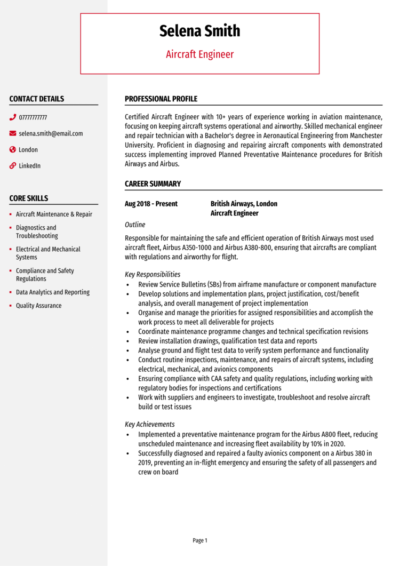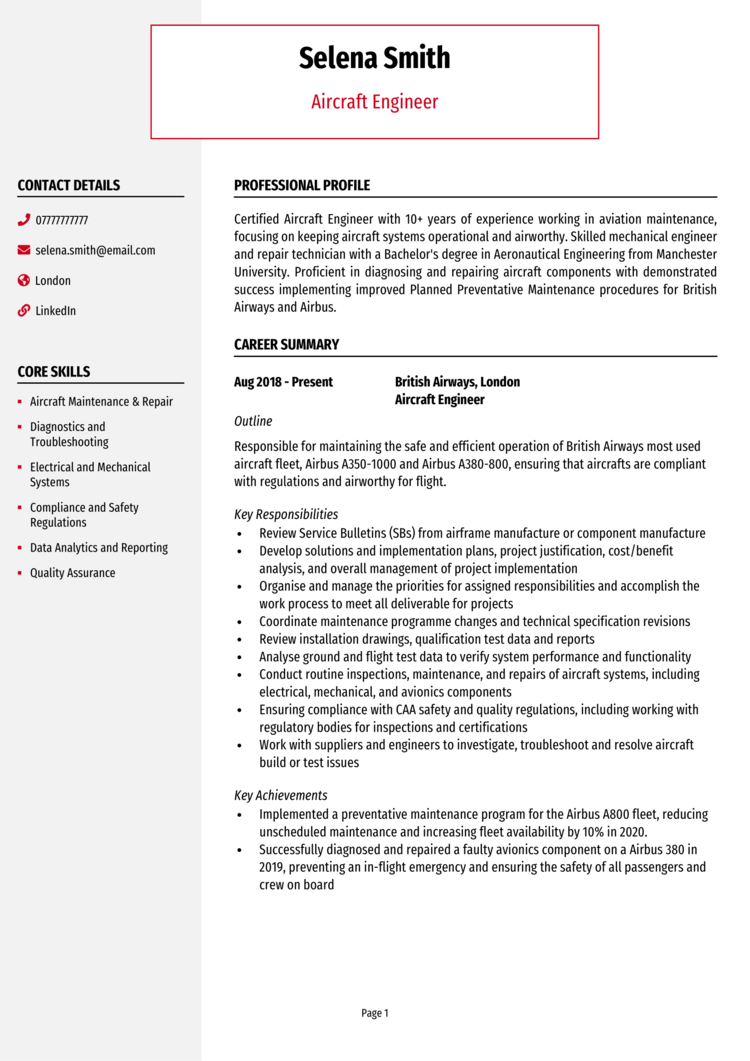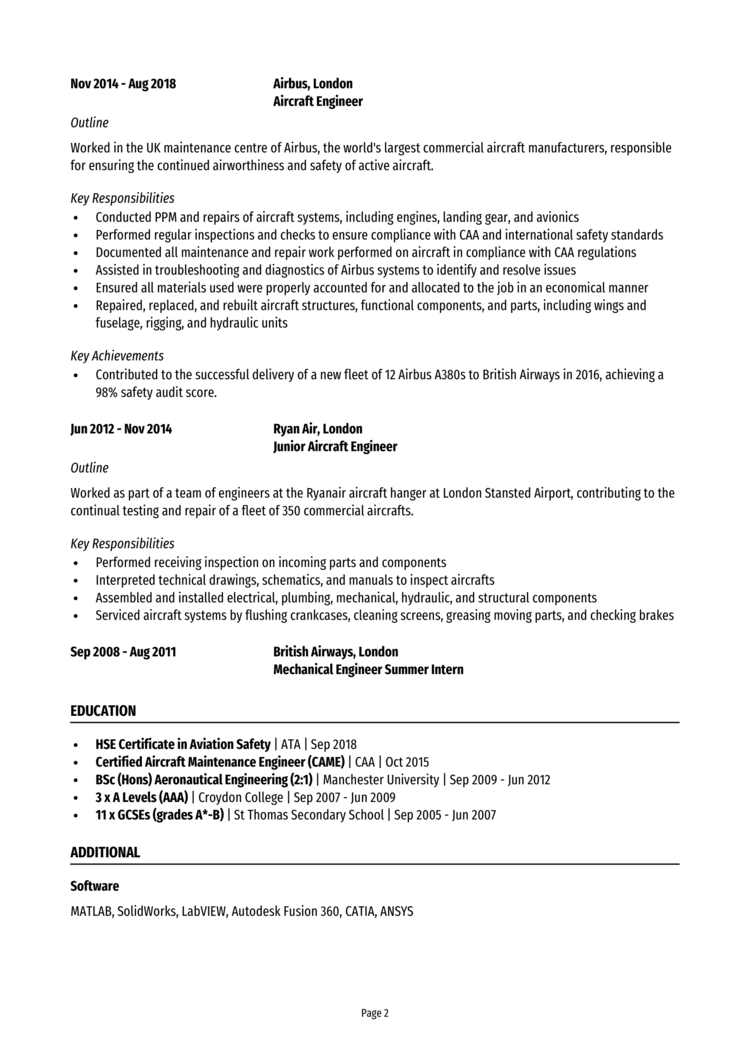You know how to help assemble, maintain and repair aircrafts, so why does assembling a CV that reflects this feel so tough?
Well, we can’t be an expert at everything. Thankfully for you, we’re here to offer our expert advice in the form of this step-by-step writing guide.
Below, we’ll share an aircraft engineer CV example along with our top tips for writing an application that will help your career take off this year.
|
Aircraft Engineer CV example
This CV example illustrates the ideal structure and format for your Aircraft Engineer CV, making it easy for busy hiring managers to quickly identify your suitability for the jobs you’re applying for,
It also gives some guidance on the skills, experience and qualifications you should emphasise in your own CV.


Aircraft Engineer CV format and structure
Your CV is the first impression you’ll make on anybody who reads it.
A disorganised, cluttered and barely-readable CV could seriously decrease your chances of landing interviews, so it’s essential to make sure yours is slick, professional and easy to navigate.
You can do this by using a clear structure and formatting your content with some savvy formatting techniques – check them out below:
Tips for formatting your Aircraft Engineer CV
- Length: Even if you’ve got tons of experience to brag about, recruiters don’t have time to read through overly lengthy CVs. Keep it short, concise and relevant – a CV length of 2 sides of A4 pages or less is perfect for the attention spans in today’s job market.
- Readability: By formatting your section headings with bold or a different colour font and using bullet points to break up large blocks of text, you can help busy recruiters quickly scan through your CV. This makes it easier for them to find important details without wasting time.
- Design & format: While it’s okay to add your own spin to your CV, avoid overdoing the design. If you go for something elaborate, you might end up frustrating recruiters who, above anything, value simplicity and clarity.
- Photos: You can add a profile photo to your CV, if you want to add some personality to it, but they are not a requirement the UK, so you don’t have to.
Quick tip: Creating a professional CV style can be difficult and time-consuming when using Microsoft Word or Google Docs. To create a winning CV quickly, try our quick-and-easy CV Builder and use one of their eye-catching professional CV templates.
CV structure
When writing your CV, it’s important to structure the content into the following key sections to ensure easy digestion by busy recruiters and hiring managers:
- Contact details: List your contact details at the top of your CV to prevent them from being overlooked.
- Profile: Begin with an introductory paragraph that captures recruiters’ attention and summarises what you have to offer employers.
- Work experience/career history: List your relevant work experience in reverse chronological order, starting with your current position.
- Education: Provide a brief summary of your education and qualifications.
- Interests and hobbies: An optional section to showcase any hobbies that highlight transferable skills relevant to your target jobs.
Now you understand the basic layout of a CV, here’s what you should include in each section of yours.
Contact Details
Begin by sharing your contact details, so it’s easy for employers to give you a call.
Keep to the basics, such as:
- Mobile number
- Email address – It should sound professional, with no slang or nicknames. Make a new one for your job applications if necessary.
- Location – Simply share your vague location, for example ‘Manchester’, rather than a full address.
- LinkedIn profile or portfolio URL – Remember to update them before you send your application.
Aircraft Engineer CV Profile
To immediately capture the attention of recruiters, begin your CV with a powerful profile (or personal statement for junior applicants).
This is a brief introductory paragraph that summarises your skills, experience, and knowledge.
It should position you as the ideal candidate for the job and encourage recruiters to read on.
How to write a good CV profile:
- Make it short and sharp: When it comes to CV profile length, less is more, as recruiters are often time-strapped. Aim for around of 3-5 persuasive lines.
- Tailor it: Recruiters can spot a generic, mass-produced CV at a glance – and they certainly won’t be impressed! Before you write your profile (and CV as a whole), read through the job advert and make a list of any skills, knowledge and experience required. You should then incorporate your findings throughout your profile and the rest of your CV.
- Don’t add an objective: Leave your career objectives or goals out of your profile. You only have limited space to work with, so they’re best suited to your cover letter.
- Avoid generic phrases: If there’s one thing that’ll annoy a recruiter, it’s a clichè-packed CV. Focus on showcasing your hard skills, experience and the results you’ve gained in previous roles, which will impress recruiters far more.
Example CV profile for Aircraft Engineer
What to include in your Aircraft Engineer CV profile?
- Experience overview: Start with a brief summary of your relevant experience so far. How many years experience do you have? What type of companies have you worked for? What industries/sectors have you worked in? What are your specialisms?
- Targeted skills: Make your most relevant Aircraft Engineer key skills clear in your profile. These should be tailored to the specific role you’re applying for – so make sure to check the job description first, and aim to match their requirements as closely as you can.
- Important qualifications: Be sure to outline your relevant Aircraft Engineer qualifications, so that anyone reading the CV can instantly see you are qualified for the jobs you are applying to.
Quick tip: If you are finding it difficult to write an attention-grabbing CV profile, choose from hundreds of pre-written profiles across all industries, and add one to your CV with one click in our quick-and-easy CV Builder. All profiles are written by recruitment experts and easily tailored to suit your unique skillset.
Core skills section
Next, you should create a bullet pointed list of your core skills, formatted into 2-3 columns.
Here, you should focus on including the most important skills or knowledge listed in the job advertisement.
This will instantly prove that you’re an ideal candidate, even if a recruiter only has time to briefly scan your CV.
Important skills for your Aircraft Engineer CV
Aircraft Systems Knowledge – Maintaining an in-depth understanding of various aircraft systems, including mechanical, electrical, and avionics systems, to diagnose and resolve issues.
Technical Drawing and Interpretation – Reading and interpreting technical drawings, blueprints, and schematics to effectively perform maintenance and repair tasks.
Maintenance and Repair – Conducting maintenance, inspections, and repairs on aircraft components and systems, ensuring compliance with safety standards and regulations.
Troubleshooting – Identifying and resolving complex technical issues, using analytical thinking and troubleshooting techniques.
Compliance with Regulations – Maintaining a thorough knowledge of aviation regulations, such as those set by the Civil Aviation Authority (CAA), to ensure adherence to safety standards and regulatory requirements.
Quality Control – Utilising meticulous attention to detail when inspecting aircraft, identifying defects, and conducting quality checks to maintain the highest level of safety and airworthiness.
Technical Documentation – Generating accurate technical reports, maintenance records, and documentation to maintain a comprehensive and organised record of maintenance activities.
Equipment and Tool Proficiency – Familiarity with a wide range of specialised tools, equipment, and software used in aircraft maintenance and repair.
Quick tip: Our quick-and-easy CV Builder has thousands of in-demand skills for all industries and professions, that can be added to your CV in seconds – This will save you time and ensure you get noticed by recruiters.


Work experience
Now that recruiters have a good overview of your skills and abilities, you need to jump into the detail of your career history.
Give them a more thorough insight into what you can do by creating a detailed list of your relevant experience.
Start with your current role, and work backwards through all the relevant positions you’ve held.
This could be freelance, contract or voluntary work too; as long as it’s related to the role you’re applying for.
Structuring each job
Whilst writing your CV, it’s essential to look at it from the eyes of a recruiter.
If they’re met with giant blocks of text which are impossible to navigate, they might get frustrated and skip onto the next CV.
Instead, make use of the 3-step structure shown below, to give them a pleasant reading experience.
Outline
Start with a 1-2 sentence summary of your role as a whole, detailing what the goal of your position was, who you reported to or managed, and the type of organisation you worked for.
Key responsibilities
Next up, you should write a short list of your day-to-day duties within the job.
Recruiters are most interested in your sector-specific skills and knowledge, so highlight these wherever possible.
Key achievements
Lastly, add impact by highlight 1-3 key achievements that you made within the role.
Struggling to think of an achievement? If it had a positive impact on your company, it counts.
For example, you might increased company profits, improved processes, or something simpler, such as going above and beyond to solve a customer’s problem.
Sample job description for Aircraft Engineer CV
Outline
Responsible for maintaining the safe and efficient operation of British Airways most used aircraft fleet, Airbus A350-1000 and Airbus A380-800, ensuring that aircrafts are compliant with regulations and airworthy for flight.
Key Responsibilities
- Review Service Bulletins (SBs) from airframe manufacture or component manufacture
- Develop solutions and implementation plans, project justification, cost/benefit analysis, and overall management of project implementation
- Organise and manage the priorities for assigned responsibilities and accomplish the work process to meet all deliverable for projects
- Coordinate maintenance programme changes and technical specification revisions
Quick tip: Create impressive job descriptions easily in our quick-and-easy CV Builder by adding pre-written job phrases for every industry and career stage.
Education section
At the bottom of your CV is your full education section. You can list your formal academic qualifications, such as:
- Degree
- GCSE’s
- A levels
As well as any specific Aircraft Engineer qualifications that are essential to the jobs you are applying for. Note down the name of the qualification, the organisation at which you studied, and the date of completion.
Hobbies and interests
The hobbies and interests CV section isn’t mandatory, so don’t worry if you’re out of room by this point.
However, if you have an interesting hobby, or an interest that could make you seem more suitable for the role, then certainly think about adding.
Be careful what you include though… Only consider hobbies that exhibit skills that are required for roles as a Aircraft Engineer, or transferable workplace skills.
There is never any need to tell employers that you like to watch TV and eat out.


Creating a strong Aircraft Engineer CV requires a blend of punchy content, considered structure and format, and heavy tailoring.
By creating a punchy profile and core skills list, you’ll be able to hook recruiter’s attention and ensure your CV gets read.
Remember that research and relevance is the key to a good CV, so research your target roles before you start writing and pack your CV with relevant skills.
Best of luck with your next application!











